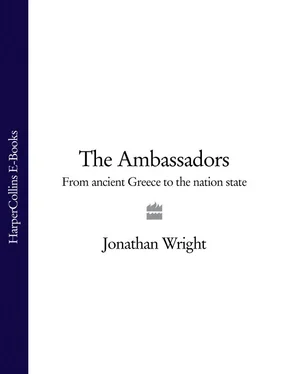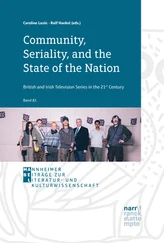What follows is a sketch of that vast history, and nothing more. It is a sketch that takes the European experience of diplomacy as its principal focus: a sketch that takes the very term ambassador (a late medieval invention) in its broadest sense. Here, we aim for the marrow of the ambassadors’ history, for the resonances and the fractures, for the things that remained the same and those that shifted – for the texture. That, and accounts of some of the most extraordinary episodes in human history.
If that is the structure, what is the purpose? To repeat, all that is really aimed at is a demonstration of the vital, very often surprising, role that ambassadors have played in the encounters between civilizations. They offer a prism through which some of the grander themes of history – shifting world-views, awakenings and reawakenings of cultural knowledge, the agonizing choices that polities habitually face between isolation and engagement – can be explored.
The ambassadorial tradition is more ancient and various than is sometimes supposed. It is almost unfeasibly diverse. Embassy was about cultural encounter, and it would sometimes be wondrous. But it could just as easily be appalling, as when Hernando Cortés, posing as an ambassador, set about the destruction of Aztec civilization. Embassy brought peace, but it was often little more than the prelude to war or political takeover.
Those same Aztecs usually only sent out ambassadors in order to threaten their neighbours. First, they would demand the payment of tribute and the erection of a statue of one of their gods in the local temple. If their advances were still being rebuffed after twenty days, more ambassadors would arrive, talking of the unhappy consequences of resistance and, to show how little they feared military engagement, providing their hosts with weapons. After another twenty days, a final party of ambassadors arrived, assuring their hosts that, very soon, their temple would be levelled and their entire population enslaved: a promise the Aztecs were especially good at keeping.
Embassy brought gifts but then, even in the guise of gifts, it also brought threats and insults. When rumours spread that an Ottoman sultan lacked the wherewithal to complete the erection of a new mosque, the shah of Persia mischievously sent him chests of rubies and emeralds. This was not done out of generosity, but to sneer at the sultan’s predicament. The sultan, fully understanding that an insult was intended, ordered the gems to be ground up and added to the mortar being used to build the mosque.
Embassy would forge marriages and alliances but it sometimes left humiliated victims in its wake. In 1160 the Byzantine emperor Manuel was looking for new wife, and envoys were sent out to peruse the likely candidates. One of them, Melisend, the sister of Raymond III, count of Tripoli, had grown excited at the prospect of so prestigious a match. In truth, she had been kept in reserve in case a more suitable alliance with the ruler of Antioch failed to materialize. The ambassadors who had recently seen ‘the girl and admired her beauty’ suddenly changed tack and abandoned negotiations when news arrived that the Antioch marriage had been confirmed.
The Byzantine chroniclers simply invented a story to conceal this rather disreputable episode of diplomatic matchmaking. ‘Severe illnesses beset the girl,’ the chronicles report, ‘and she was in serious danger…her body shuddered and shook extremely…The radiance of her appearance, which previously gleamed beautifully, was shortly altered and darkened. Seeing her, our eyes filled with tears at such a withered meadow.’ It was an utter fiction. Melisend had undergone no such transformations; she had merely, and on a sudden, been supplanted in the emperor’s affections. 5
Sometimes embassy was spectacular. In 1162 that same Byzantine emperor received an ambassador in Constantinople ‘with magnificent banquets…charmed him with horse races, and according to custom set alight some boats and skiffs with liquid fire and absolutely gorged the man with spectacles in the hippodrome’. 6 Sometimes it was dull, or even became a chore. The Venetian nobility were in the habit of retreating to their villas on the island of Murano whenever a new ambassador was about to be appointed.
The ritual was often splendid, but diplomatic dignity was just as often dispensed with. The Renaissance monarch Francis I was in the habit of accompanying visiting ambassadors on a horseback journey through the streets of Paris where he set about pelting his subjects with eggs and rocks. 7 The history of the ambassadors was ultimately about this balance between the impressive and the mundane, the triumphs and the disasters.
It might also be assumed that the history of the ambassadors is one of ever-evolving sophistication and complexity, culminating in the clockwork diplomacy of the modern world. It would be an arrogant assumption to make. Almost every society that has opted to investigate rather than to shun the rest of the world has mounted the same debates about what qualities a good ambassador ought to possess, about the elaborate rules and rituals of encounter. They have faced the same tensions between suspicion of the outside world and an urge to confront it; between behaving decorously towards other peoples and making sure to assert their cultural superiority.
Among the oldest surviving written records of diplomacy are the Amarna letters, several hundred clay tablets discovered at the end of the nineteenth century. Their faded cuneiform inscriptions record the relations between the rulers of Egypt and the greater and lesser kingdoms of the ancient Near East – Babylon, Assyria, and the rest – during the fourteenth century BC.
The letters show kings despatching ambassadors to complain about their fellow rulers’ use of disrespectful language, about the failure to send envoys to enquire about their health. When the merchants of one king are robbed and killed by the subjects of another, swift justice is demanded: the culprits are to be bound and returned with the money they have stolen; and the murderers are to be executed. If such measures are not taken, future travellers, ambassadors included, will be at risk, which threatens to bring diplomatic relations between the two kingdoms to an abrupt end. Nor are insults to the royal dignity any more likely to improve diplomatic relations: one ruler is utterly devastated when his brother’s name is mentioned before his own on a tablet.
One monarch suggests to another that, if he is going to take the trouble to send him gold, then it might as well be of a decent quality and in the same quantities as his father used to supply. A letter from the Cypriot kingdom of Alasiya warns the Egyptian king not to complain about receiving insufficient levies of copper. As a matter of fact, so prodigious an effort has been made that there is not a copper-worker left alive on the entire island, and suitable gifts are expected in recompense – namely, silver, sweet oil, an ox and a specialist in eagle omens. 8
The Amarna letters reveal a consummate understanding of the value and vagaries of diplomacy. The motivations that would so often inspire ambassadors’ missions – the fostering of trade, the payment of tribute, the search for alliances, the scolding of rivals – are all present, as are the pride, rivalry and petulance without which human diplomacy would be unrecognizable. Perhaps the story of the ambassadors provides an antidote to that thriving modern disease: the assumption that the past is either a quaint curiosity or an inevitable route-march to the present.
This, then, is a book of journeys, a book about the individuals who, far more tangibly than any impersonal force of history, wrote the human story: the individuals who did as much as any conqueror, merchant, scholar or circumnavigating adventurer to help the world understand itself. Sometimes ambassadors would travel absurd distances, as did the thirteenth-century monks who trekked from Peking to Paris and from Flanders to the Asian steppe. Sometimes they journeyed no further than the nearest Greek city-state, or from one Renaissance court to another. They could be vile, snobbish and stupid, or they could be astute, sympathetic and wise, but, throughout all their missions, ambassadors were an inevitable facet of human history – offering an obvious way for squabbling rivals, potential allies and scattered civilizations to meet.
Читать дальше












